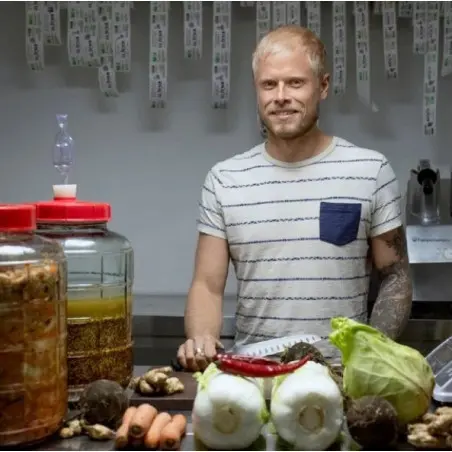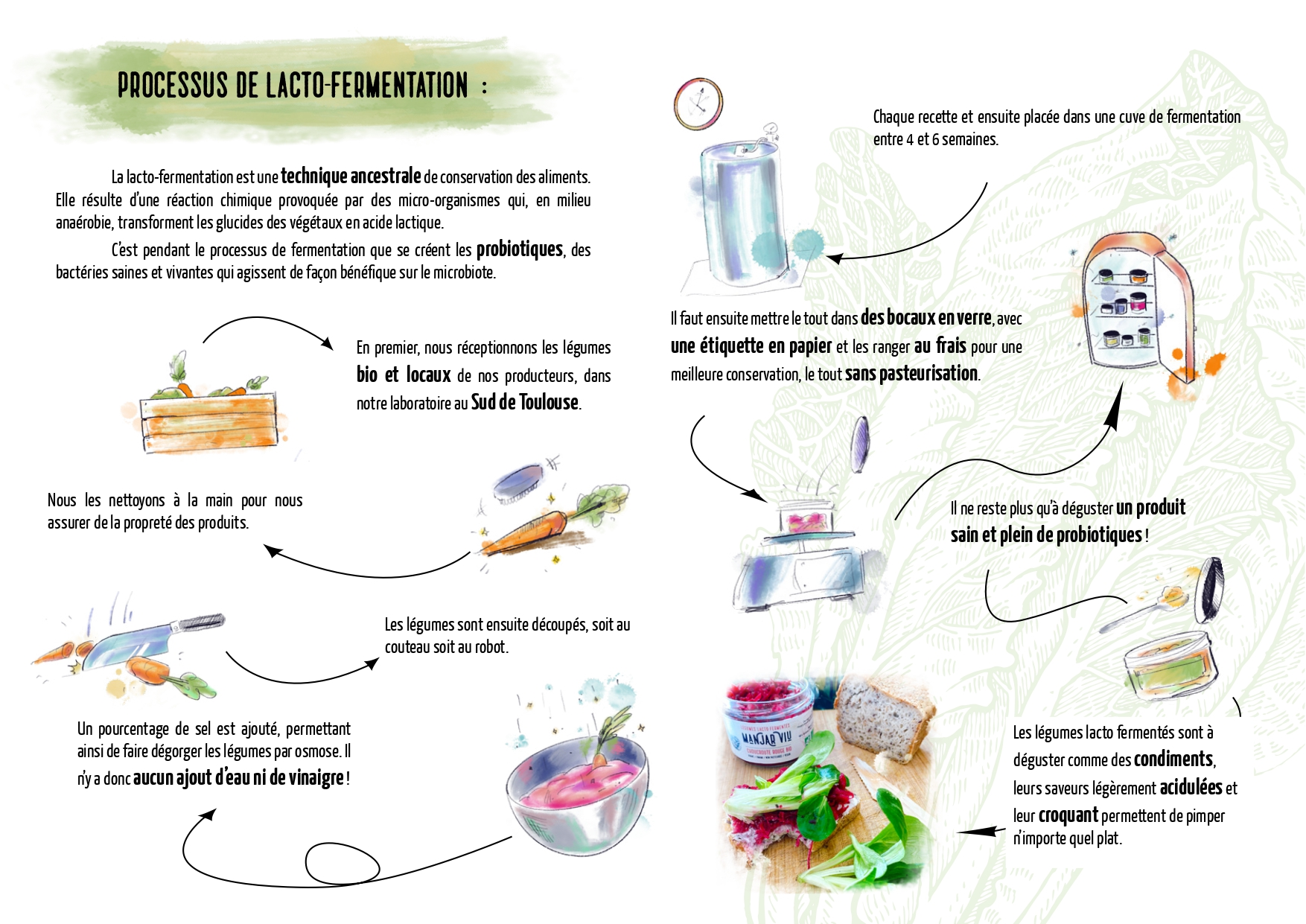- On sale!
- -€0.50















Organic kimchi
Certified organic
Unpasteurized
Artisanal production in France
Glass jar of 220 g or 400 g
It is with great enthusiasm that we present to you the lacto-fermented, unpasteurized, and certified organic products from MANJAR VIU ("Living food" in Occitan) !
🌶️ This kimchi is made with Chinese cabbage, carrots, and lacto-fermented black radish, enhanced with garlic, ginger, and Espelette pepper, all certified organic. He was prepared with care, in an artisanal manner, and without any pasteurization.
> It contains no preservatives, artificial flavors, or vinegar (which is antiseptic). Behind this jar of kimchi, a taste adventure and an explosion of authentic flavors await you with every bite: the tangy and slightly spicy taste of the preparation, along with the richness of its umami flavor, will bring you a unique sense of satisfaction !
> Kimchi is a traditional Korean food. It is said to be a secret to good health, and each family has its own recipe. It is the richest source of probiotics and live enzymes, and due to its pre-digested state caused by the fermentation process, these nutrients are highly bioavailable for the body. It's not for nothing that kimchi is known for being one of the healthiest dishes in the world !
> Unpasteurized, you will be able to enjoy the benefits of lacto-fermentation. For this reason, it is advisable to always use clean utensils and to keep the jar cool (consume it within a month after opening).
> Make sure to firmly pack the leftover vegetables in their juice for better preservation. Juice can be added to sauces, dressings, or fresh vegetable juices! We recommend consuming a small amount of lacto-fermented vegetables each day (ideally adding one or two tablespoons to your meals), rather than having a single meal based on this food.
> Find a recipe for Kimcheese offered by Manjar Viu ! ! (you can replace the cheese with vegan cheese!)
> As well as a recipe by Aurélie available on our YouTube channel:
🌶️ What is the umami flavor ?
Umami is the 5th taste detected by the tongue after salty, sweet, sour, and bitter. The taste is often described as the savory delight that deepens the flavor! The famous "come back for more" taste, that's it! Umami is often associated with a sensation of roundness and depth in the mouth, enhancing the satisfaction and complexity of dishes.> It is the result of a chemical reaction caused by certain yeasts, bacteria, or fungi that, in an anaerobic environment (without oxygen), transform the carbohydrates of plants into lactic acid. The environment gradually becomes more acidic, thus preventing the development of other organisms.
> This method has no connection with lactose. Its name comes from the bacteria involved, called lactic bacteria or lactobacilli, which do not come from milk. Lactic acid is a natural preservative that inhibits the development of pathogenic bacteria and germs that could degrade vegetables. Thus, the vegetables retain all their vitality, or even more !
Fermentation is thus an effective means of preservation and a culinary art that offers a wide range of surprising textures and flavors. It is also an ancient method of food preservation, which requires different steps and regular monitoring to ensure that the final product is of the highest quality.
> Fermentations all have in common the strengthening of the immune system, the support of the intestinal flora, and they provide valuable aid to digestion. Fermented foods are indeed highly recommended for the well-being of the digestive system. In addition to improving digestion and providing probiotics, fermentation enhances the bioavailability of nutrients.

🌶️ To learn more, also check out our blog articles:
Lacto-fermentation, a true health asset !
What are the benefits of fermented foods ?
Lacto-fermentation reveals the flavors of foods and promotes the balance of the intestinal microbiota. The vegetables remain alive, are easier to digest, detoxifying... and delicious !
🌶️ The main advantage of lacto-fermented vegetables is their concentration of probiotics. These beneficial bacteria enrich, regulate, and rebalance your gut flora. Thanks to them, you regain good intestinal health, and as we know, the digestive system is our second brain! Taking care of it with probiotics helps improve many functions of your body.
🌶️ Lacto-fermentation is therefore a process of multiplying nutrients through a living microcosmic activity. Bacteria, enzymes, and yeasts transform simple sugars into organic acids, proteins into amino acids, while also increasing vitamins and digestibility.
Lacto-fermented foods have several health benefits:
> they are rich in active ingredients and micronutrients (high content particularly in vitamins C, B12, and B3). For example, cabbage turned into sauerkraut sees its vitamin C content increase by up to 300% !
> They facilitate the assimilation of nutrients. Without the help of bacteria, many proteins, complex sugars, and vitamins would reach the end of the digestive tract in an "undigested" state, meaning that these molecules would not have been sufficiently broken down during the digestion process and would be too complex to cross the intestinal membrane and be absorbed by the body !
> They are rich in enzymes, highly digestible, and promote the development of healthy bacteria in the intestines.
> They contain acids that ensure detoxification and detoxination functions and play an antibiotic and preventive role against degenerative diseases.
🌶️ To learn more about the benefits of lacto-fermentation and kimchi, also check out our blog articles on this topic:
> What are the benefits of kimchi ?
> What are the benefits of fermented foods ?
> Lacto-fermentation, a true health asset !
Located in Lahage, near Toulouse, within the Bordanova Third Place, Mathieu, at the helm of Manjar Viu, specializes with passion and dedication in the lacto-fermentation of vegetables. Collaborating with local organic farmers, his company ensures a fast and direct supply of vegetables, without intermediate storage. The production follows the rhythm of the seasons and accepts all shapes and sizes of vegetables to minimize food waste and transport emissions.
The products of Manjar Viu are natural, without preservatives or vinegar, allowing fermentation to continue after storage.
🌶️ We had the pleasure of meeting Mathieu in October 2024, find our interview with him in this video:
🌶️ Moreover, with Mathieu having a culinary background, he became passionate about food preservation, finding lacto-fermentation ideal for its ecological benefits and longevity. With Manjar Viu, he aims to offer nutritious and delicious recipes while highlighting local cultures. He also published a recipe book in September 2022, titled "Do Yourself Good, Eat Living," to promote the daily use of lacto-fermented vegetables, an excerpt of which is as follows:
"Today, in a constantly changing world, where uncertainty is permanent, a sanitized, polluted world increasingly devoid of nutrients, my wish with this project is to offer tasty and healthy recipes to boost vitality."
Ingredients: Chinese cabbage* (53.5%), carrots* (25.7%), radishes* (17%), Espelette pepper* (0.5%), garlic*, ginger*, and salt
*ingredients from organic farming.

Packaging: Available in a 220g or 400g glass jar
DDM : Consume within one month after opening.
Storage method: Keep refrigerated between 4 and 8 degrees.
| Average nutritional values | 100 g |
Energy | 20.54 Kcal |
| Carbohydrates (of which sugars: | 2.8 g 1.0 g |
| Fibers | 1.7 g |
| Proteins | 1.5 g |
| Salt | 1.5 g |
Ces produits pourraient vous intéresser